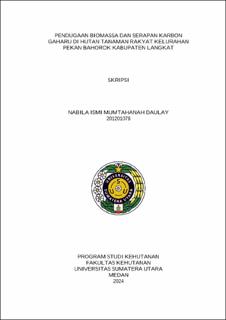| dc.description.abstract | This research was conducted in the People's Plantation Forest of Bahorok
Village, using agarwood stands as the main sample in the study. The agarwood
plant, also known as agarwood, eaglewood, or aleowood, is famous for its aromatic
resin. This plant is naturally distributed in several countries such as China (Hong
Kong, Hainan), Pakistan, Iran, India, Nepal, Bhutan, Bangladesh, Sri Lanka,
Cambodia, Vietnam, Laos, Thailand, Indonesia, Myanmar, Malaysia, Singapore,
and the Philippines. This study aims to determine the biomass potential, carbon
reserves, and oxygen based on age class and stand type using two different
formulas. The variables measured in data collection include species, diameter, and
height. The plots created were square-shaped, totaling 28 plots with a size of 20×20
m. The magnitude of biomass can be determined using the allometric equation
developed by two researchers, Chave and Zaenal. The results of the species
identification show that the species found are Aquilaria malacensis, Aquilaria
subintegra, Aquilaria microcarpa, and Gyrinops verstegii. The results of the
biomass calculation were then used to estimate carbon reserves, carbon
absorption, and oxygen production. The research results show that the average
estimation of agarwood biomass is around 1034.36 kg/ha (Chave) and 1067.08
kg/ha (Zaenal). Carbon reserves of 486.19 kg/ha (Chave) and 501.53 kg/ha
(Zaenal). Carbon dioxide absorption of 483.61 kg/ha (Chave) and 498.88 kg/ha
(Zaenal). The potential oxygen production is 353.04 kg/ha (Chave) and 364.18
kg/ha (Zaenal). | en_US |


